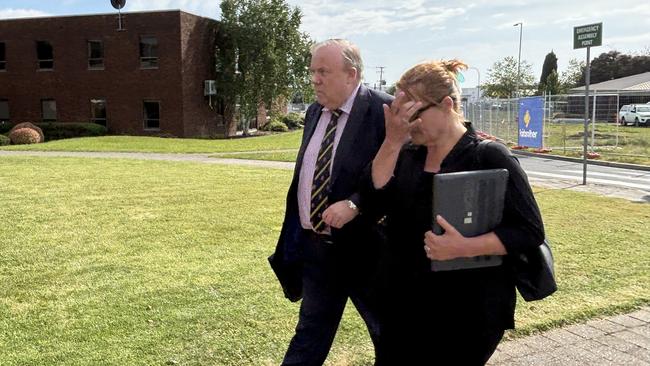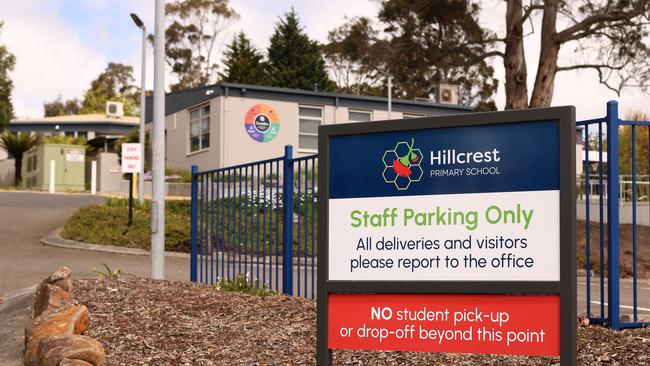Pegs used to hold down Hillcrest jumping castle ‘not up to standard’
Pegs used to hold down the jumping castle that became airborne at Hillcrest Primary School in 2021 were ‘not up to standard’, according to an expert. Here’s a wrap up of day five of the trial.

Tasmania
Don't miss out on the headlines from Tasmania. Followed categories will be added to My News.
A mechanical engineer has told a court that all of the inflatables involved in the Hillcrest tragedy were not up to standard.
Also, on the same day, the court heard that the pegs used to hold down the jumping castle that was flung 10m into the air failed tests done after the event that resulted in six children killed.
Engineering reports and witnesses dominated day five of the criminal hearing into the Hillcrest tragedy.
Taz-Zorb owner Rosemary Gamble has pleaded not guilty to one count of failure to comply with health and safety duty category 2 in relation to the fatal incident at Hillcrest Primary School in December 2021.

Mechanical engineer Roderick McDonald told the Devonport Magistrates Court on Monday that a report he did found that the jumping castle involved in the tragedy did not meet Australian standards.
“The crux of the findings were the castle was not compliant to - in fact, all of the device were not compliant to - the Australian standards,” Mr McDonald said.
“The operations were not compliant to Australian standards, and the systems that were in place were not compliant with - so things like the choice of the anchorage system was not the one to the manufacturer’s instruction and not what would be the standard.”
On Monday, the court was also shown an engineering report by Geoton that examined the pegs used that day and compared them to other types.
Geoton drilled five bores on the Hillcrest Primary School oval where the jumping castle was and took ground samples to analyse the soil.
Geoton employee Sean Shahandeh told the court that it also performed pullout strength tests on the pegs at Hillcrest.

“The results of the field pull-out tests showed the capacity for the pegs used during the incident is below the minimum required pull-out force specified…with the exception of when the pegs were inserted vertically into the ground, and the direction of the load was applied at 90 degrees to the angle of the peg.” the Geoton report said.
Mr Shahandeh told the court the Australian Standards needed to be more comprehensive and detailed for operators.
He also said that if someone wanted to access a copy of them, they would need to pay between $150 and $200.
Earlier in the day, another mechanical testing engineer tasked with seeing how much force a D-ring and metal bar from the scene of the Hillcrest tragedy could withstand and the strength of both items shared those results in court.
The court heard Worksafe Tasmania asked Prakash Salian to perform a hardness and loading test on both items in the jumping castle from Hillcrest Primary School that was flung around 10m in the air.
The D-ring failed when a continuous, gradual force over 72 seconds reached 5.948 kilonewtons was applied.
The hardness test on the D-ring found it had an average of 161HV10, which is where a value of 100 Vickers is applied and a load of 10kg makes an indent in the item.
The witness told the court that the tests on the metal bar had almost the same results.
Pegs used to hold down Hillcrest jumping castle ‘not up to standard’
Earlier: A court has been told that the pull-out force capacity of the pegs used on the jumping castle at Hillcrest Primary School in 2021 before it became airborne was below Australian standards.
Geotechnical engineer Sean Shahandeh gave evidence during the criminal hearing into Hillcrest hearing.
The company he works for, Geoton, was tasked with examining the pegs used on the day and comparing them to other types.
Geoton drilled five bores on the school oval where the jumping castle was and took samples of the ground to analyse the soil.
They also did pullout strength tests on the pegs at Hillcrest as well.
“The results of the field pull-out tests showed the capacity for the pegs used during the incident is below the minimum required pull-out force specified…with the exception of when the pegs were inserted vertically into the ground, and the direction of the load was applied at 90 degrees to the angle of the peg.” the Geoton report said.
Mr Shahandeh told the court the Australian Standards needed to be more comprehensive and detailed.
He also said that if someone wanted to access a copy of them, they would need to pay between $150 and $200.
Mechanical engineer gives evidence at Hillcrest trial
Earlier: A mechanical testing engineer tasked with seeing how much force a D-ring and metal bar from the scene of the Hillcrest tragedy could withstand and the strength of both items has shared the results in court.
WorkSafe Tasmania asked Prakash Salian to perform a hardness and loading test on both items in the jumping castle from Hillcrest Primary School that was flung around 10 metres in the air.
The D-ring failed when a continuous, gradual force over 72 seconds reached 5.948 kilonewtons was applied.
The hardness test on the D-ring found it had an average of 161HV10, which is where a value of 100 Vickers is applied and a load of 10kg makes an indent in the item.
Mr Salian said that the tests on the metal bar had almost the same results.
Hillcrest trial enters second week
Earlier: The second week of the criminal hearing into the Hillcrest tragedy begins today.
Taz-Zorb owner Rosemary Gamble is fighting a charge against her concerning the events of December 16, 2021, at Hillcrest Primary School, where six children died after a jumping castle became airborne.
She has pleaded not guilty to one count of failure to comply with health and safety duty category 2.
In week one of the hearing, a pair of Taz-Zorb workers, a weather expert, a police constable, and the sales manager of the Chinese company that sold Ms Gamble the jumping castle at the centre of the Hillcrest tragedy took to the witness stand.
The hearing at the Devonport Magistrates Court is expected to wrap up on November 15.




